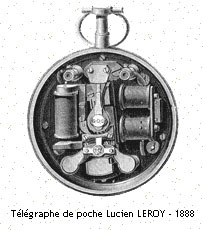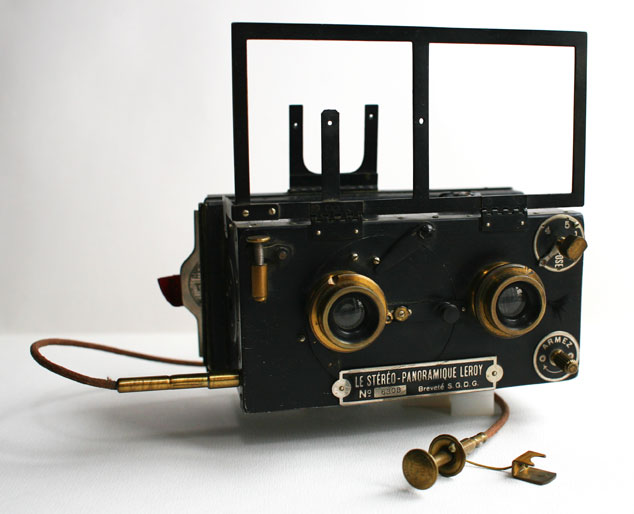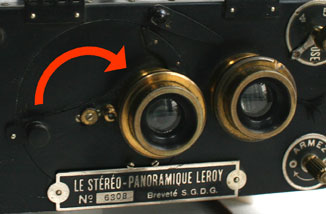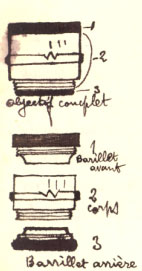
 |
 Lucien
Leroy was a former student from the Ecole Centrale des Arts et
Manufactures of Paris. He was one of these brilliant engineers who
participated to the great renown of the french technology until the 30s. Lucien
Leroy was a former student from the Ecole Centrale des Arts et
Manufactures of Paris. He was one of these brilliant engineers who
participated to the great renown of the french technology until the 30s.
As inventor-engineer, his name is linked to several famous inventions.
One of the most known is an
electrical impulse distributor that he invents in 1894 together with Charles Bazin.
This system will be used by Albert Londe for his researches related to
time-lapse photography. Lucien Leroy has also interest in electronic
transmissions. He made several equipments in this domain such as a
military telegraphic receptor and an incredible
pocket telegraph.His works on time-lapse photography allows him
to meet another inventor-engineer : Charles Dessoudeix. This last one is
a specialist in horology. Charles Dessoudeix had a small factory that he
sold to Charles Bazin.
Later on, Lucien Leroy will acquire this factory and progressively
transforms it in a prosperous company, producing high precision cameras. |
|

Stereo-Panoramique Leroy (1903) with Lacour-Berthiot lenses
and cable release Antinoüs |
The Stereo-Panoramique Leroy is a very ingenious camera, which
combines high-performance and multi-formats. Its life duration in the
different catalogs of the camera resellers attests of its high quality
and its commercial success-story. Its novelty was relying on its
capability to easily produce both 6 x 6 cm stereoscopic views and 6 x 13
cm panoramic views.
Other cameras were also presenting this characteristic, such as the
jumelle cameras based on a horizontal decentration. The beauty of the
solution found
by Lucien Leroy to easily switch from one format to the other has placed
this camera much ahead of all its opponents.
|
|
Lucien Leroy's idea was to locate the shutter behind the lenses. The
platform supporting the right lens can rotate on its axis in order to
move this lens in to a central position. When using the panoramic mode,
the lens not used had to be closed up with a lens cap.

Another interesting characteristic is that the hole of each shutter
has a surface which is twice bigger than the one of the rear lens. This
is increasing by 50% the quantity of light arriving on the plate 6 x 13
cm when using the panoramic mode, ensuring a better luminosity of the
pictures.
Regarding optical characteristics, the Stereo-panoramique was offered
with different lenses from several famous manufacturers. All these
lenses have a focal distance between 80 and 82 mm; this was a good
compromise for both proposed formats.
 In
1914, the proposed lenses (all equiped with an iris) was the following: In
1914, the proposed lenses (all equiped with an iris) was the following:
It is probable that starting from 1914, the German lenses made by
Zeiss or Goerz were no longer mounted on Leroy cameras.
For information, the camera presented here has been initially purchased
with Krauss Protar lenses but these ones have been replaced later on by
Lacour-Berthiot lenses, much more performing.
5 shutter speeds (+ pose) are available using a selector
located on the top right of the front face of the camera.
Position 1 gives 1/10 second, 2 = 1/25 second, 3 = 1/45 second, 4 = 1/60
second and 5 = 1/75 second.
This camera was also allowing to produce autochromes thank to special
plate frames and two corrective lenses.
|
|
I had the great privilege
to purchase this camera from a lady who was owning it since several
years. It was in her family since 1914, date when the grand-father of
her husband acquired it directly from the Lucien Leroy's factory.
 In
addition to the fact she accepted to pass on this camera to me, I felt a
lot of emotions when this lady gave me a letter dated from August 1914
which was addressed to the grand-father of her husband. In this letter,
written and signed from Lucien Leroy himself, this one is describing how
to clean the two lenses of the camera. In
addition to the fact she accepted to pass on this camera to me, I felt a
lot of emotions when this lady gave me a letter dated from August 1914
which was addressed to the grand-father of her husband. In this letter,
written and signed from Lucien Leroy himself, this one is describing how
to clean the two lenses of the camera.
Can we imagine today the CEO of Canon so deeply involved in the
maintenance activities of his own company ? Click on the signature on
the left to discover this incredible document and appreciate its style
and the precision of the given answer. |
 Nombre
de visiteurs Nombre
de visiteurs
Number of visitors |


![]()
